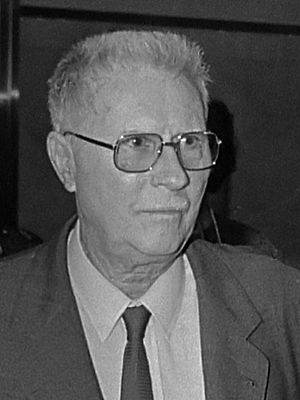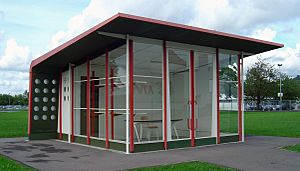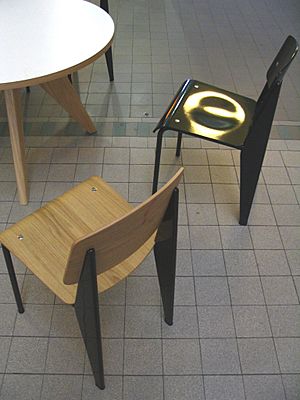Jean Prouvé facts for kids
Quick facts for kids
Jean Prouvé
|
|
|---|---|

Prouvé in 1981
|
|
| Born | 8 April 1901 Nancy, France
|
| Died | 23 March 1984 (aged 82) Nancy, France
|
| Spouse(s) | Madeleine Schott |
| Children |
|
| Parent(s) |
|
Jean Prouvé (born April 8, 1901 – died March 23, 1984) was a very talented French person. He started as a metal worker but taught himself to be an architect and designer. A famous architect named Le Corbusier called him a "constructeur," which means he was great at mixing building design with engineering. Jean Prouvé was amazing at using factory methods to build beautiful buildings and furniture. His design skills were not limited to one area. During his career, Jean Prouvé worked on architectural design, industrial design, structural design, and furniture design.
Jean Prouvé: A Master Builder and Designer
His Early Life and Artistic Family
Jean Prouvé was born in Nancy, France. He was the second of seven children. His father, Victor Prouvé, was an artist, and his mother, Marie Duhamel, was a pianist. The Prouvé family was part of a lively group of artists. This group included the glass artist Emile Gallé and the furniture designer Louis Majorelle.
Jean grew up surrounded by the ideas of the École de Nancy. This was an art group his father belonged to. Their main goals were to make art easy for everyone to see and enjoy. They also wanted to connect art with industry and with helping society. These ideas strongly influenced Jean's work throughout his life. He once said, "I was raised in a world of artists and scholars, a world which nourished my mind."
Learning and Starting His Own Workshop
Between 1914 and 1917, Jean Prouvé studied at the school of fine arts in Nancy for three years. After that, he became an apprentice to a blacksmith named Émile Robert. He then worked at a metal workshop in Paris.
In 1923, Jean opened his first workshop in Nancy. This was the start of many workshops and studios he would have. He made things like wrought iron lamps, chandeliers, and handrails. He also began designing furniture, such as his "Chaise inclinable" (reclining chair) in 1924.
As a skilled metal craftsman, local architects hired him from 1923 to 1939. He helped them with their Art Deco projects. Over time, he slowly moved away from decorative styles. He started to prefer smooth surfaces made of folded metal plates. He used this material to design storefronts, elevators, and furniture. For example, he designed furniture for student housing in 1932.
Building for the Future: Mass Production and War Efforts
In 1930, Prouvé helped create the Union of Modern Artists. This group believed in logic, balance, and purity in design. In 1931, he opened a successful business called "Ateliers Jean Prouvé." He started working with French architects on big projects. These included the Maison du Peuple (House of the People) in Clichy, an aviation club, and an army camp. He also worked with other famous designers like Charlotte Perriand and Pierre Jeanneret on furniture.
During World War II, his workshop stayed busy. They made bicycles and a special stove called "Pyrobal" that could burn any type of fuel. Prouvé liked to work on projects for public services like health, education, and government. This showed his social ideals and also allowed for making many items at once. By 1936, he had a catalog of standard designs for hospitals, schools, and offices.
The idea of making things in large numbers inspired Prouvé. He developed and patented industrial products using folded sheet metal for buildings. These included movable walls, metal doors, and elevator cages. When the French government started offering paid vacations for workers, Prouvé designed the BLPS (1937–39). This was a prefabricated steel vacation home. It weighed less than two tons. Five workers could set up or take down the 3.3 square meter (35.5 square feet) house in just four to five hours.
In 1939, he designed portable barracks for the French army. Later, "Ateliers Jean Prouvé" was asked to mass-produce frame houses for refugees. At this time, the world needed cheap, quickly built homes. Prouvé became known as a leader in this field, alongside the American designer R. Buckminster Fuller.
During the war, Prouvé was also active in the French Resistance. After the war, he was honored for his involvement. He was named mayor of Nancy. He also became a member of the Advisory Assembly and an Inspector for Technical Education.
After World War II, people became very interested in new ways and materials to mass-produce furniture. Companies that made materials like formica, plywood, aluminum, and steel supported design shows. Designers like Prouvé, Charlotte Perriand, and others showed their new ideas at these events.
In 1947, Prouvé built the Maxéville factory. Here, he made furniture and did a lot of research on how to use aluminum in buildings. He also designed the Ferembal Demountable House (1948). This building was made with steel frames and could be taken apart. In 1949, Prouvé and his brother Henri won a contract to build 14 homes near Paris. This project showed off his lightweight, prefabricated metal building system.
Designing for Different Climates: The Maison Tropicale
Prouvé's studio built industrial buildings from aluminum. They also sent hundreds of aluminum sheds to Africa. He designed a special aluminum prefabricated house called the Maison Tropicale (Tropical House) for use in Africa. These houses were made to help with the shortage of homes and public buildings in France's African colonies.
Prouvé designed and built three prototype Maisons Tropicales between 1949 and 1951. One was sent to Niamey, the capital of Niger. Two others went to Brazzaville, which was the capital of the French colony of Middle Congo at the time. The two in Brazzaville were put together on the same property. One was a house, and the other was an office for a French company that sold aluminum products. One of the Brazzaville houses and the one in Niamey were later taken apart and sent back to Paris. The second, larger Brazzaville house was made from folded steel and aluminum. All the parts were flat, light, and could be packed neatly into a cargo plane for easy transport.
Challenges and Later Works
Prouvé's business faced difficulties in 1952. However, Le Corbusier, one of his first clients, continued to ask him for technical advice. After Maxéville, Prouvé started a new company called "Constructions Jean Prouvé."
In 1953, he designed the outside of the restaurant at the Hotel de France in Conakry, Guinea. It had shutters that could pivot and open towards the sea. In 1954, a clergyman named Abbé Pierre asked for help to build emergency homes for people without shelter. Prouvé designed the 'Maison des Jours Meilleurs' (A house for better days). This house was 57 square meters (about 613 square feet) and had two bedrooms and a large living area. A few people with simple tools could build it in just seven hours.
In 1956, Prouvé was asked to design a schoolhouse that could be easily taken apart and moved. His answer was the Villejuif Demountable House (1956). This was a lightweight building with steel supports holding up a wooden roof that stuck out. The school was later taken apart, and its parts were used in other buildings.
Jean Prouvé's metal furniture was made in many of his workshops. He often worked with others, most famously with Charlotte Perriand and Pierre Jeanneret. His style was different from the steel furniture of the Bauhaus movement. He preferred using sheet metal that was "bent, pressed, compressed rather than welded." He believed in knowing his materials well, working with other artists and craftsmen, and always keeping up with new technical ideas. He also believed in making decisions quickly. Prouvé was important in developing the idea of "nomadic architecture," meaning buildings that could be moved. He thought of a chair like a house, designing both to be portable.
In 1957, Prouvé started the Industrial Transport Equipment Company. He worked on projects like the Rotterdam Medical School, the Exhibition Center in Grenoble, and the outside of the Orly Airways Terminal. In 1958, he helped design La maison du Sahara, a modern house made for very extreme weather conditions. Between 1952 and 1962, he worked on the Musée des Beaux Arts du Havre. This museum was made of glass, steel, and aluminum. In 1958, Prouvé worked with the sculptor Alexander Calder to build the steel base for La Spirale. This was a huge moving sculpture for the UNESCO site in Paris.
Later Years and Legacy
From 1957 to 1970, Prouvé taught at the Conservatoire des Arts et Métiers in Paris. One of his biggest projects in his later years was a building for the Ministry of National Education (1970). This was a metal skyscraper designed around a large inner courtyard. It was planned to be built at La Défense. In 1971, Prouvé was the head of the jury that chose the design for the Centre Pompidou in Paris. He played a very important role in choosing the winning design by Richard Rogers and Renzo Piano.
Jean Prouvé passed away in Nancy in 1984.
Jean Prouvé's Lasting Impact
Today, the Maison Jean Prouvé (Jean Prouvé House) belongs to the City of Nancy. They rent it to an architect and their family, but the public can visit it at certain times. Prouvé's workshop from his factory has even been rebuilt on the grounds.
His work is now part of many private and public collections around the world. These include the Centre Pompidou in Paris and the Museum of Modern Art in New York. There are permanent galleries dedicated to Prouvé's work at the Musée des beaux-arts and Musée de l’Histoire du Fer in Nancy. In 2012, there was an exhibition of his metalwork at the Musée de l’École de Nancy. Another show looked at his impact on the city during and after World War II. One of his prefabricated Maisons Tropicales, designed for Africa, was also set up at the Musée des beaux-arts.
Exhibitions of His Work
Major exhibitions of Jean Prouvé's work include:
- "Jean Prouvé: Constructeur, 1901–1984," at the Centre Pompidou, Paris (1990–91).
- "Three Nomadic Structures," at Columbia University (2002).
- "Jean Prouvé: Three Nomadic Structures," at the Pacific Design Center, Museum of Contemporary Art, Los Angeles (2005).
- "Jean Prouvé: A Tropical House," at the Hammer Museum, Los Angeles (2006).
- "Jean Prouvé: The Poetics of the Technical Object," at the Vitra Design Museum, Weil am Rhein (2006–07). This show traveled to many places, including the Museum of Modern Art, Kamakura & Hayama; Deutsches Architekturmuseum, Frankfurt; Netherlands Architecture Institute, Maastricht; Hotel de Ville de Boulogne-Billancourt, Paris; Design Museum, London; and Museo dell'Ara Pacis, Rome.
- "Ateliers Jean Prouvé," at the Museum of Modern Art, New York (2008–09).
- A multi-exhibition tribute at the Musée des beaux-arts, Nancy (2012).
- "A Passion for Jean Prouvé: From Furniture to Architecture," at Pinacoteca Agnelli, Turin (2013).
- The exhibition "Jean Prouvé : Architect for Better Days" was shown at the LUMA Foundation in Arles from October 20, 2017, to Spring 2018.
Images for kids
See also
 In Spanish: Jean Prouvé para niños
In Spanish: Jean Prouvé para niños




